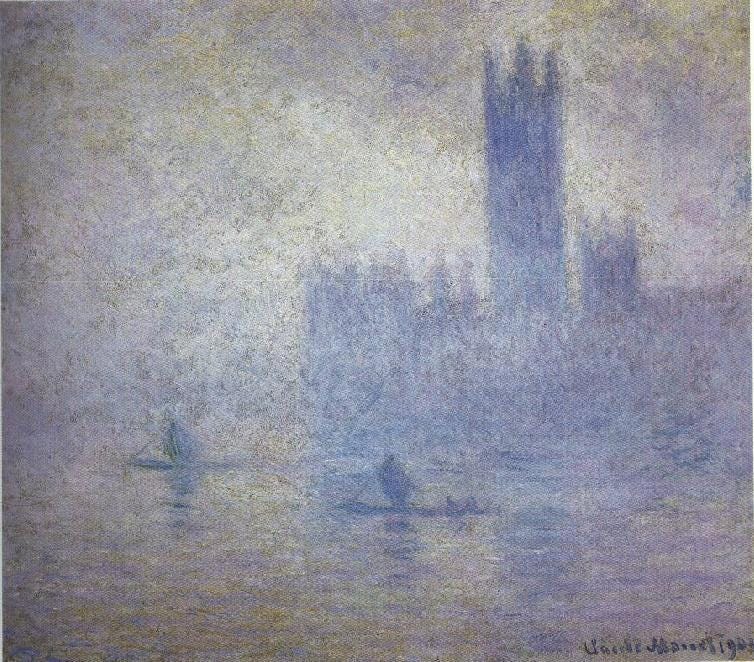Lessons from fog and gravity
There’s plenty to learn from the giant leaps in art and science that will improve your urbanism advocacy.
I don’t know if urbanism is science or art, but I do know its outcomes are best with a dose of creativity.
There’s plenty to learn from the giant leaps in art and science that will improve your urbanism advocacy. Happy, healthy communities aren’t made from being stuck in a bygone era.
Impressionist painters didn’t discover fog. It was always there, but it wasn’t something people were discussing much in the early 19th century leading up to the impressionists and tonalists. Each of those artistic movements created illusions of reality with familiar scenes. James McNeill Whistler was an influential figure and one of the original tonalists. Here’s what he had to say about finding inspiration from natural elements previously left off the canvas:
“And when the evening mist clothes the riverside with poetry, as with a veil, and the poor buildings lose themselves in the dim sky, and the tall chimneys become campanili, and the warehouses are palaces in the night and the whole city hangs in the heavens, and fairy-land is before us—then the wayfarer hastens home; the working man and the cultured one, the wise man and the one of pleasure, cease to understand, as they have ceased to see, and Nature, who, for once, has sung in tune, sings her exquisite song to the artists alone.”
Claude Monet is probably the most famous of the impressionist bunch. Monet’s focus shifted from clear objects to the effects of atmosphere and light, after he stumbled into the London fog. Critics would argue about deeper meanings, whether impressionism was creating a dreamy or nightmarish mood for London, angelic or demonic. But the meaning (or lack thereof) isn’t what got me thinking about these 19th century art movements. It’s the idea that something was always there and it took artists to draw the attention of normies to it.
300 years before Monet and Whistler, Nicolaus Copernicus was making the shocking case that Earth and other planets revolved around the sun, rather than Earth being the center of everything. He didn’t get everything right. Copernicus had no concept of gravity, so he wasn’t clear on how the celestial blobs swirled around each other or why they all orbited the sun. Not many decades later, Isaac Newton watched an apple fall out of a tree. He organized his math homework and philosophy into laws of gravity that were eventually used to describe planetary motion.
In hindsight, it seems almost childish to talk about major leaps in art and science because the advancements seem so obvious. Of course a foggy picture with shadowy figures in motion makes me feel uneasy. Of course gravity makes things fall to the ground.
Generations ahead of us will probably read stories about our era that begin like this: “Once upon a terrible time, America’s most educated city planners were convinced that cities optimized for motor vehicle traffic would be the safest and most prosperous.” Things that don’t even cross our minds today as possible outcomes will be boring in their obviousness later.
Consider space:
In 1960, science fiction was the only reasonable place for stories about a group of humans traveling beyond our atmosphere, circling the globe, and returning safely in their ship.
In 1961, Project Mercury launched multiple such voyages, making all sorts of discoveries about how people and machines function in weightless environments..
Consider music:
In 1965, anyone interested in hearing a new band had to either listen live to one of a few radio stations, or suffer through a friend’s attempt to sing.
In 1966, the portable cassette recorder was introduced, making it possible for anyone to make and play recordings without cables and microphones.
Consider city planning:
In 2022, land use planners and politicians still worked under the assumption that the social and physical harms of zoning were necessary and would always exist.
In 2023, a brave local planning department liberated its community from the crushing burdens of zoning, becoming a model for others to follow. (Maybe.)
There’s no reason to always be operating from a yesteryear mindset with issues like affordable housing, traffic engineering, parks planning, and intersection design. Challenge what others take for granted. Open your eyes to the hidden potential of your block, your street, your neighborhood, and your city.



What is the 2023 city you reference